2007 CHEVROLET SILVERADO air condition
[x] Cancel search: air conditionPage 45 of 684
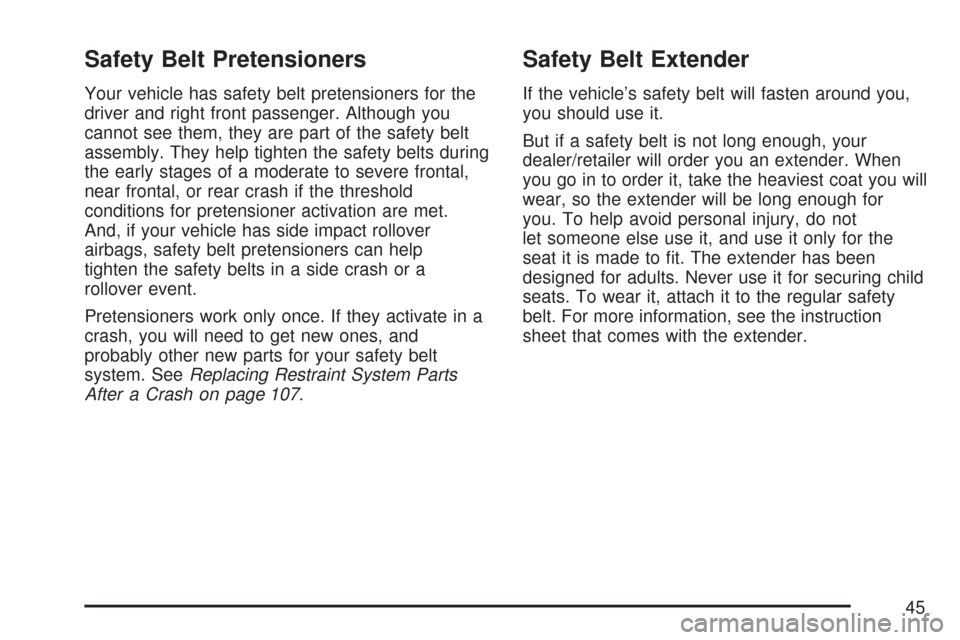
Safety Belt Pretensioners
Your vehicle has safety belt pretensioners for the
driver and right front passenger. Although you
cannot see them, they are part of the safety belt
assembly. They help tighten the safety belts during
the early stages of a moderate to severe frontal,
near frontal, or rear crash if the threshold
conditions for pretensioner activation are met.
And, if your vehicle has side impact rollover
airbags, safety belt pretensioners can help
tighten the safety belts in a side crash or a
rollover event.
Pretensioners work only once. If they activate in a
crash, you will need to get new ones, and
probably other new parts for your safety belt
system. SeeReplacing Restraint System Parts
After a Crash on page 107.
Safety Belt Extender
If the vehicle’s safety belt will fasten around you,
you should use it.
But if a safety belt is not long enough, your
dealer/retailer will order you an extender. When
you go in to order it, take the heaviest coat you will
wear, so the extender will be long enough for
you. To help avoid personal injury, do not
let someone else use it, and use it only for the
seat it is made to �t. The extender has been
designed for adults. Never use it for securing child
seats. To wear it, attach it to the regular safety
belt. For more information, see the instruction
sheet that comes with the extender.
45
Page 58 of 684
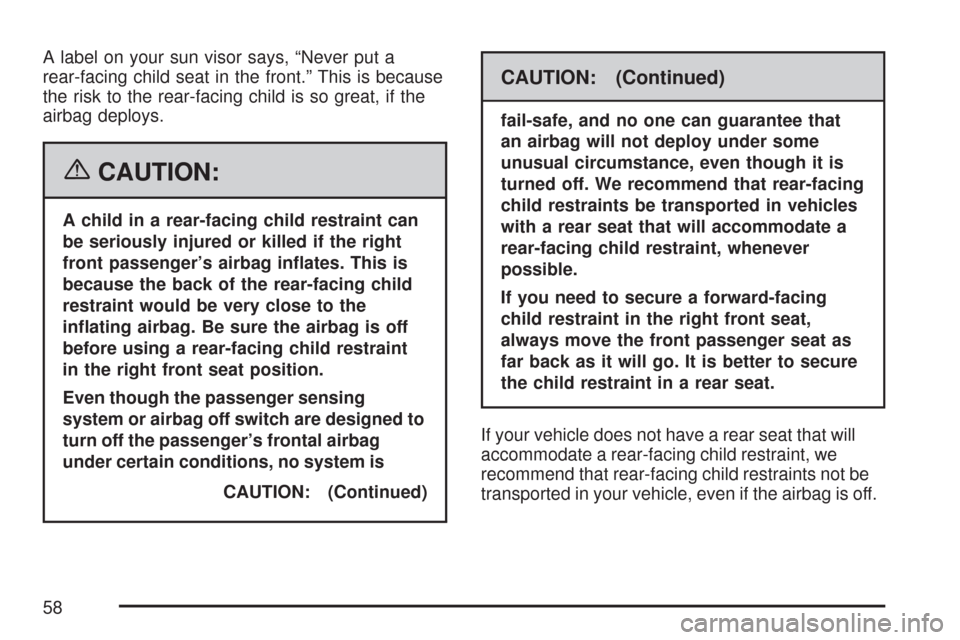
A label on your sun visor says, “Never put a
rear-facing child seat in the front.” This is because
the risk to the rear-facing child is so great, if the
airbag deploys.
{CAUTION:
A child in a rear-facing child restraint can
be seriously injured or killed if the right
front passenger’s airbag in�ates. This is
because the back of the rear-facing child
restraint would be very close to the
in�ating airbag. Be sure the airbag is off
before using a rear-facing child restraint
in the right front seat position.
Even though the passenger sensing
system or airbag off switch are designed to
turn off the passenger’s frontal airbag
under certain conditions, no system is
CAUTION: (Continued)
CAUTION: (Continued)
fail-safe, and no one can guarantee that
an airbag will not deploy under some
unusual circumstance, even though it is
turned off. We recommend that rear-facing
child restraints be transported in vehicles
with a rear seat that will accommodate a
rear-facing child restraint, whenever
possible.
If you need to secure a forward-facing
child restraint in the right front seat,
always move the front passenger seat as
far back as it will go. It is better to secure
the child restraint in a rear seat.
If your vehicle does not have a rear seat that will
accommodate a rear-facing child restraint, we
recommend that rear-facing child restraints not be
transported in your vehicle, even if the airbag is off.
58
Page 92 of 684

The threshold level can vary with speci�c vehicle
design. Roof-mounted airbags are not intended
to in�ate in rear impacts. Both roof-mounted
rollover airbags will deploy when either side of the
vehicle is struck, during a rollover, or in a
severe frontal impact.
In any particular crash, no one can say whether
an airbag should have in�ated simply because
of the damage to a vehicle or because of what the
repair costs were. For frontal airbags, in�ation is
determined by what the vehicle hits, the angle
of the impact, and how quickly the vehicle slows
down. For roof-mounted rollover airbags,
in�ation is determined by the location and severity
of the impact or a rollover event.
The airbag system is designed to work properly
under a wide range of conditions, including off-road
usage. Observe safe driving speeds, especially
on rough terrain. As always, wear your safety belt.
SeeOff-Road Driving on page 392for tips on
off-road driving.
If the GVWR (Gross Vehicle Weight Rating) of
your vehicle is 8,500 lb (3 855 kg) or above, your
vehicle has single stage airbags. If the GVWR
is below 8,500 lb (3 855 kg), your vehicle has dual
stage airbags. You can �nd the GVWR on thecerti�cation label on the rear edge of the driver’s
door. SeeLoading Your Vehicle on page 427
for more information.
Single Stage Airbags
If your vehicle has frontal airbags with single stage
deployment and your vehicle goes straight into
a wall that does not move or deform, the threshold
level is about 12 to 16 mph (19 to 26 km/h). The
threshold level can vary, however, with speci�c
vehicle design, so that it can be somewhat above
or below this range.
Dual Stage Airbags
If your vehicle has frontal airbags with dual stage
deployment, the amount of restraint will adjust
according to crash severity. Your vehicle has
electronic frontal sensors which help the sensing
system distinguish between a moderate and a
more severe frontal impact. For moderate frontal
impacts, these airbags in�ate at a level less
than full deployment. For more severe frontal
impacts, full deployment occurs. If the front of your
vehicle goes straight into a wall that does not
move or deform, the threshold level for the
reduced deployment is about 9 to 16 mph
(14 to 26 km/h), and the threshold level for a full
deployment is about 18 to 23 mph (29 to 37 km/h).
92
Page 96 of 684
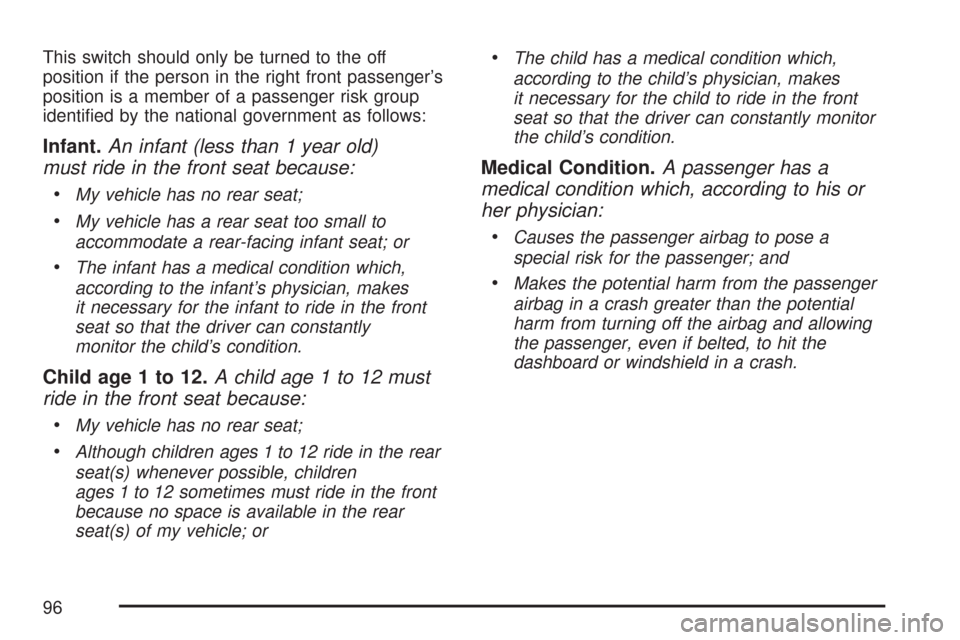
This switch should only be turned to the off
position if the person in the right front passenger’s
position is a member of a passenger risk group
identi�ed by the national government as follows:
Infant.An infant (less than 1 year old)
must ride in the front seat because:
My vehicle has no rear seat;
My vehicle has a rear seat too small to
accommodate a rear-facing infant seat; or
The infant has a medical condition which,
according to the infant’s physician, makes
it necessary for the infant to ride in the front
seat so that the driver can constantly
monitor the child’s condition.
Child age 1 to 12.A child age 1 to 12 must
ride in the front seat because:
My vehicle has no rear seat;
Although children ages 1 to 12 ride in the rear
seat(s) whenever possible, children
ages 1 to 12 sometimes must ride in the front
because no space is available in the rear
seat(s) of my vehicle; or
The child has a medical condition which,
according to the child’s physician, makes
it necessary for the child to ride in the front
seat so that the driver can constantly monitor
the child’s condition.
Medical Condition.A passenger has a
medical condition which, according to his or
her physician:
Causes the passenger airbag to pose a
special risk for the passenger; and
Makes the potential harm from the passenger
airbag in a crash greater than the potential
harm from turning off the airbag and allowing
the passenger, even if belted, to hit the
dashboard or windshield in a crash.
96
Page 99 of 684
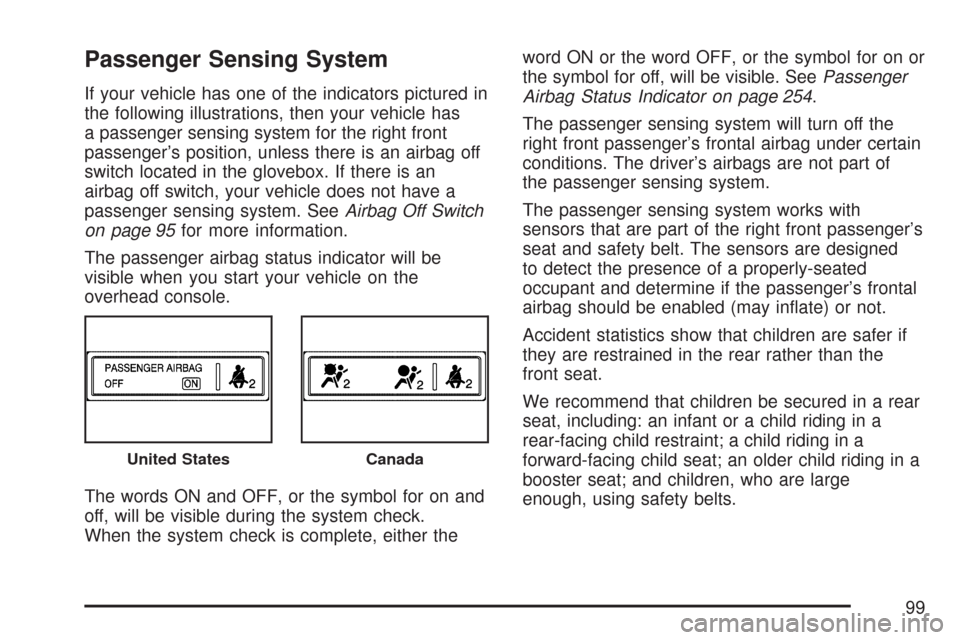
Passenger Sensing System
If your vehicle has one of the indicators pictured in
the following illustrations, then your vehicle has
a passenger sensing system for the right front
passenger’s position, unless there is an airbag off
switch located in the glovebox. If there is an
airbag off switch, your vehicle does not have a
passenger sensing system. SeeAirbag Off Switch
on page 95for more information.
The passenger airbag status indicator will be
visible when you start your vehicle on the
overhead console.
The words ON and OFF, or the symbol for on and
off, will be visible during the system check.
When the system check is complete, either theword ON or the word OFF, or the symbol for on or
the symbol for off, will be visible. SeePassenger
Airbag Status Indicator on page 254.
The passenger sensing system will turn off the
right front passenger’s frontal airbag under certain
conditions. The driver’s airbags are not part of
the passenger sensing system.
The passenger sensing system works with
sensors that are part of the right front passenger’s
seat and safety belt. The sensors are designed
to detect the presence of a properly-seated
occupant and determine if the passenger’s frontal
airbag should be enabled (may in�ate) or not.
Accident statistics show that children are safer if
they are restrained in the rear rather than the
front seat.
We recommend that children be secured in a rear
seat, including: an infant or a child riding in a
rear-facing child restraint; a child riding in a
forward-facing child seat; an older child riding in a
booster seat; and children, who are large
enough, using safety belts.
United StatesCanada
99
Page 105 of 684
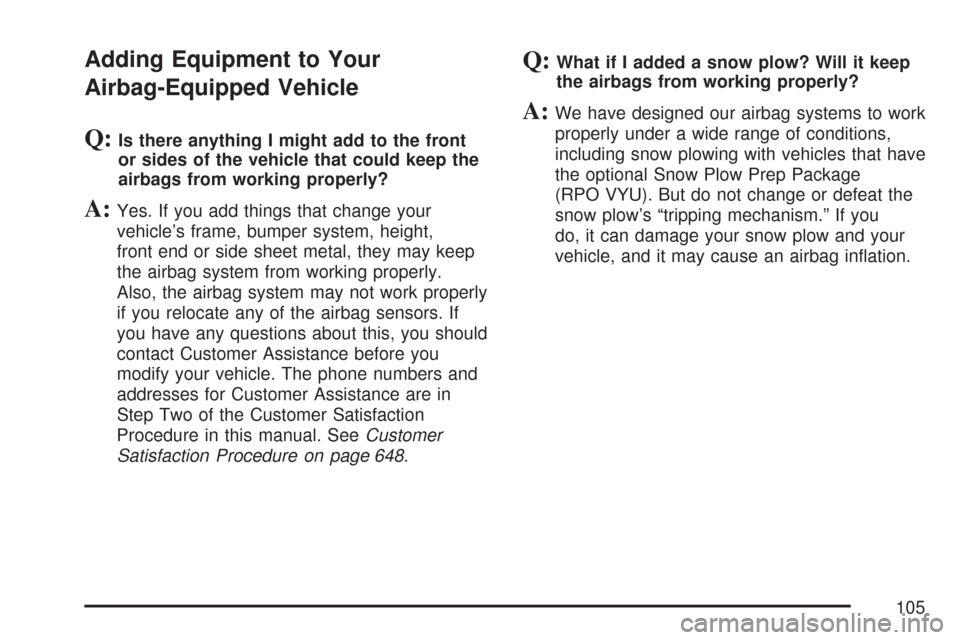
Adding Equipment to Your
Airbag-Equipped Vehicle
Q:Is there anything I might add to the front
or sides of the vehicle that could keep the
airbags from working properly?
A:Yes. If you add things that change your
vehicle’s frame, bumper system, height,
front end or side sheet metal, they may keep
the airbag system from working properly.
Also, the airbag system may not work properly
if you relocate any of the airbag sensors. If
you have any questions about this, you should
contact Customer Assistance before you
modify your vehicle. The phone numbers and
addresses for Customer Assistance are in
Step Two of the Customer Satisfaction
Procedure in this manual. SeeCustomer
Satisfaction Procedure on page 648.
Q:What if I added a snow plow? Will it keep
the airbags from working properly?
A:We have designed our airbag systems to work
properly under a wide range of conditions,
including snow plowing with vehicles that have
the optional Snow Plow Prep Package
(RPO VYU). But do not change or defeat the
snow plow’s “tripping mechanism.” If you
do, it can damage your snow plow and your
vehicle, and it may cause an airbag in�ation.
105
Page 117 of 684
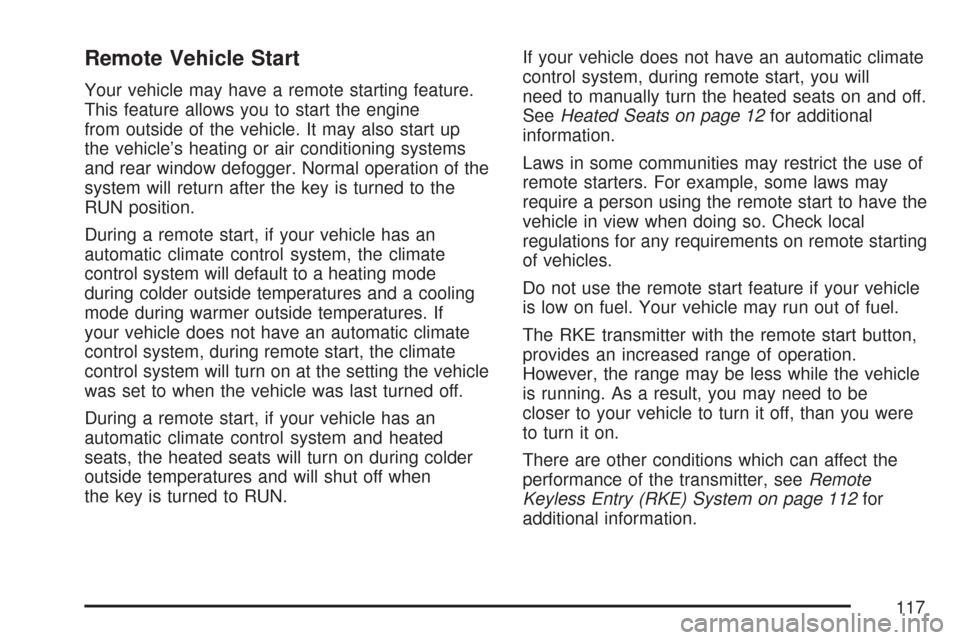
Remote Vehicle Start
Your vehicle may have a remote starting feature.
This feature allows you to start the engine
from outside of the vehicle. It may also start up
the vehicle’s heating or air conditioning systems
and rear window defogger. Normal operation of the
system will return after the key is turned to the
RUN position.
During a remote start, if your vehicle has an
automatic climate control system, the climate
control system will default to a heating mode
during colder outside temperatures and a cooling
mode during warmer outside temperatures. If
your vehicle does not have an automatic climate
control system, during remote start, the climate
control system will turn on at the setting the vehicle
was set to when the vehicle was last turned off.
During a remote start, if your vehicle has an
automatic climate control system and heated
seats, the heated seats will turn on during colder
outside temperatures and will shut off when
the key is turned to RUN.If your vehicle does not have an automatic climate
control system, during remote start, you will
need to manually turn the heated seats on and off.
SeeHeated Seats on page 12for additional
information.
Laws in some communities may restrict the use of
remote starters. For example, some laws may
require a person using the remote start to have the
vehicle in view when doing so. Check local
regulations for any requirements on remote starting
of vehicles.
Do not use the remote start feature if your vehicle
is low on fuel. Your vehicle may run out of fuel.
The RKE transmitter with the remote start button,
provides an increased range of operation.
However, the range may be less while the vehicle
is running. As a result, you may need to be
closer to your vehicle to turn it off, than you were
to turn it on.
There are other conditions which can affect the
performance of the transmitter, seeRemote
Keyless Entry (RKE) System on page 112for
additional information.
117
Page 142 of 684
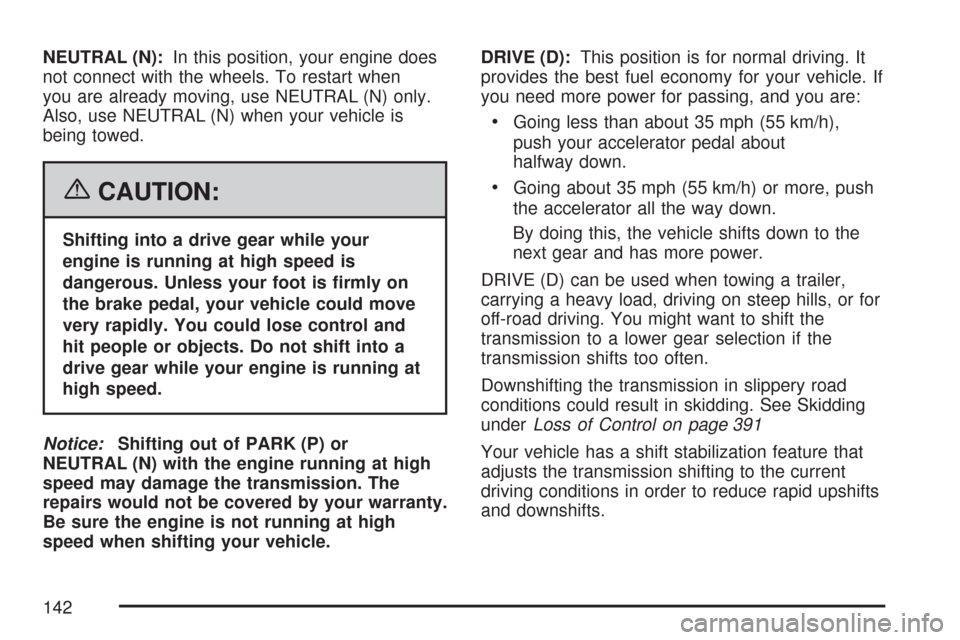
NEUTRAL (N):In this position, your engine does
not connect with the wheels. To restart when
you are already moving, use NEUTRAL (N) only.
Also, use NEUTRAL (N) when your vehicle is
being towed.
{CAUTION:
Shifting into a drive gear while your
engine is running at high speed is
dangerous. Unless your foot is �rmly on
the brake pedal, your vehicle could move
very rapidly. You could lose control and
hit people or objects. Do not shift into a
drive gear while your engine is running at
high speed.
Notice:Shifting out of PARK (P) or
NEUTRAL (N) with the engine running at high
speed may damage the transmission. The
repairs would not be covered by your warranty.
Be sure the engine is not running at high
speed when shifting your vehicle.DRIVE (D):This position is for normal driving. It
provides the best fuel economy for your vehicle. If
you need more power for passing, and you are:
Going less than about 35 mph (55 km/h),
push your accelerator pedal about
halfway down.
Going about 35 mph (55 km/h) or more, push
the accelerator all the way down.
By doing this, the vehicle shifts down to the
next gear and has more power.
DRIVE (D) can be used when towing a trailer,
carrying a heavy load, driving on steep hills, or for
off-road driving. You might want to shift the
transmission to a lower gear selection if the
transmission shifts too often.
Downshifting the transmission in slippery road
conditions could result in skidding. See Skidding
underLoss of Control on page 391
Your vehicle has a shift stabilization feature that
adjusts the transmission shifting to the current
driving conditions in order to reduce rapid upshifts
and downshifts.
142